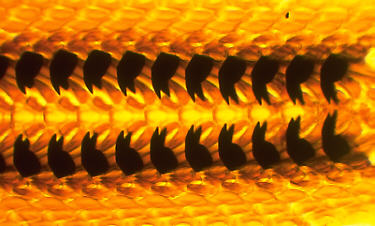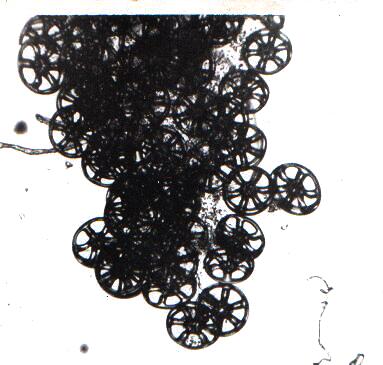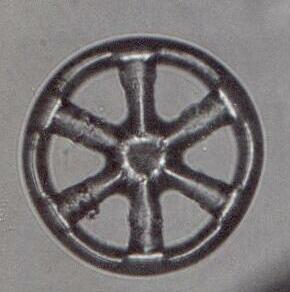When we used to have a vegetable garden in the summers, my wife would always insist that I pick, wash, and inspect the leaf lettuce and spinach leaves before she would use them for salads. The reason was those slick, slimy, slippery, sickening, sneaky, ravenous slugs which also like lettuce and spinach. I tried to no avail to explain that slugs are simply snails without shells and, I reasoned: "You don't mind snails,..." I was repaid with a glare and a shudder. Clearly, this was not an issue amenable to reason and I had the distinct impression that if I persisted in my defense of slugs, I might get slugged.
I must confess to not having been a very conscientious gardener and I tended to regard the slugs as a fringe benefit. I'm perfectly willing to admit that slugs are not the peacocks of the slippery, slimy critter set—that distinction is reserved for certain of the nudibranchs—but slugs do have some interesting characteristics, in particular, their rows and rows of beautifully colored teeth (under polarized light, that is) and they don't even use toothpaste, let alone, fluoride. Perhaps that was the basis for my wife's distaste—somewhere in early childhood she must have come across one of these creatures with a large chunk of spinach caught in its teeth and this was revealed when it smiled at her like a Cheshire slug.
The strange band of rows and rows of teeth in slugs, snails, nudibranchs, whelks, chitons, limpets, and certain other mollusks is known as a radula (plural: radulae). If you've ever kept an aquarium in which you let a nice carpet of algae grow on the sides, and if you also had some snails in it, then you very likely noticed interesting little tracks through the algae and you probably thought that the snails were navigating tiny riding lawnmowers up and down the sides. However, the truth is almost as bizarre. The radula can be extended through the mouth and moved up and down by a complex series of muscles. The radula acts like a rasp, tearing off pieces of algal mat which are ingested, thus leaving the tracks. The teeth are composed primarily of chitin, which is tough, durable, hard, and, in this instance, sharp, giving them the appearance, under the microscope, of very formidable weapons indeed. Relative to the size of the body, the radula can be enormous. In some snails, I have found radulae nearly as long as the body. The radula is like a flexible parabola lined with several rows of teeth and the muscles pull it back and forth, making it a remarkably effective feeding mechanism—if you like algae.

Snail radula (Genus Katharina)
To extract the radula for examination, the first step is to build a miniature guillotine to remove the head. The French have always argued that the guillotine is humane and they eat snails, so they should know!(?) So, collect the right kind of snails, have your mother or wife or chef get spinach and make garlic sauce and then you're in business—you get specimens and haute cuisine all in one day.
After removing the head—and if you're a tad squeamish, it's perfectly all right to use preserved specimens, so long as the preservative is pH neutral—so remove the head and place it in sodium hypochlorite (ordinary household bleach will do—Caution: Caustic!) And after several days and a few changes of bleach, you will discover a slim ribbon, also largely chitinous, with rows of lovely teeth arranged in intricate patterns. When observed under polarized light, the results are spectacular. Try a compensator as well for further dazzlement. Also, if you use preserved specimens, you'd better cancel the order for spinach and garlic sauce.
Naturally, as one would expect, radulae vary greatly in size, form, number of teeth, and even use. One such modification might stun you, quite literally. The cone shells (Conus) have modified their radulae into a strip with a series of single, long grooved teeth which are barbed at the end. Part of the foot has also been modified into a proboscis-like tube through which one of these teeth can be ejected like a dart. This tooth is attached to the radular strip by a very thin membranal "string" and when the tooth is discharged into a prey or enemy, a poison sac, injects a powerful toxin on contact. The strength and composition of these toxins varies, but there are recorded instances of human death resulting from just such a tiny tooth.
Another interesting modification can be found in the pteropods or "sea butterflies". Fortunately, they are small enough that they pose no threat to human beings. These lovely looking creatures live in the planktonic layer of the ocean and possess teeth that are modified into hooks which grasp their prey and pull it to the mouth where it is swallowed whole.
Nudibranchs have radulae well
worth examining and one species of dorid which I found in Maine also has
tiny calcareous structures in the cerata (or gills) extending from its
back. And, of course, nudibranchs are frequently flamboyantly colorful
and attractive for very definite reasons. They are, in a sense, the
Teddy boys—the elegant punks of the marine world, and, in terms of sheer
outrageousness of color combinations and gorgeous undulations, they put
any Teddy boy or modern punkster to shame. Why do I refer to these
remarkable mollusks as punks? Because, it's almost as though, through
their flamboyant displays, they're saying to potential prey—"O.K. buddy,
you wanna try it on? Come on, give me your best shot." However,
if it's a British nudibranch—"I say, old bean, do your worst, you disgusting
bit of codswallop."
If you don't believe me, check out
this marvelous site for marvelous
sights.
But what's all this display about? Well, as you probably guessed, it has to do with a sort of aggressive defense. Let me give you two examples. Nudibranchs have an astonishing variety of cerata or dorsal projections which they create and they are not merely decorative. Since, we have already determined that they are compulsive and resplendent exhibitionists, it is quite clear that they are sending a message, namely, that there are serious consequences to be considered in attacking them.
Some of these protrusions, like those of the dorid which I mentioned, have calcareous spicules and, to a small predator, such a mouthful of grit might be unpleasant indeed. Other forms are more heavily armed and some have cerata that contain sulfuric acid, which makes for a dining experience not quickly forgotten. To me, however, the most amazing nudibranch defense is a real tour de force. Certain types feed on hydroids which have nematocysts or "stinging cells" which are used for food gathering and defense. The nudibranchs don't digest the nematocysts nor do they pass them on through their digestive tracts. Instead, these stinging cells are moved through their own tissue and up into the cerata to be used now by the nudibranch as a defense—a mouthful of stinging cells can surely be a strong deterrent for some kinds of predators.
Nature often hides delicate, elegant, and beautiful structures in places where we would not expect to find such things. Many creatures—not just slugs—strike us as being ugly, if not downright repulsive, and sometimes we have to shift mental gears to be able to go beyond surface appearances and discover the extraordinary delights that might otherwise elude us completely. Think for a moment about pond scum. (Sometimes I have to remind my colleagues, when they use that phrase in a derogatory fashion, that pond scum is a lovely and wonderful contribution to the universe.) Look at some strands of Spirogyra (long tubes with delicately coiled strings of cells within) under the microscope or take a gander at the exquisite desmids and then tell me that pond scum is something slimy and ugly.
Now I will admit that few of the sea cucumbers are likely to win any beauty contest, especially after they have been preserved and have contracted and lost most of their color. In fact, if you get a large, preserved Stichopus with its prominent warts, it looks like a veal sausage that's gone bad. Pentacta look like small brown pickles; Lissothuria and Chirodota look like semi-transparent, slimy sacs with tentacles; and Cucumaria does indeed (when preserved) look like a bloated greenish-gray cucumber with thick leathery skin. I can hear you saying : "Yuck! Go on to something more attractive and interesting!" Well, I must confess to a fondness for sea cucumbers and so you'll just have to let me ramble a bit. In all fairness, some of the sea cucumbers are quite colorful when living and present a very attractive bouquet of tentacles.
What are sea cucumbers and why am I talking about them here? Sea cucumbers are holothuroids which is a subdivision of the phylum Echinodermata which includes starfish, serpent stars, sea urchins, sand dollars, sea biscuits, and crinoids or sea lilies. Many, but not all of these creatures have pentagonal symmetry and their phylum name means "hedgehog skin" or "spiny skin". Indeed most of the echinoderms have plates, spines, ossicles, or spicules—so now you know why I'm talking about sea cucumbers in this context. In many species, spicules or ossicles are imbedded in the skin or, in some cases, occur in small clumps scattered just under the epidermis.
The geometry and architectonics of Nature are astonishing. These humble and generally unprepossessing creatures could fill a micro-museum with the variety and beauty of their spicules. Some species have only a few ossicles scattered randomly under the epidermis, whereas others have a layer densely packed with tiny plates. In many instances, these irregular plates look as though someone had taken flat pieces of glass and punched holes in them. Two of the most striking kinds of holothuroid ossicles are the "anchors" and the "wheels". The anchors look like they might fit on a tiny charm bracelet. The wheels, which can be found on the small worm-like holothuroids of the genus Chirodota, appear, to the naked eye, like small clumps of sand imbedded just under the surface of the translucent skin. In fact, when I first saw a specimen of Chirodota, I though that these clumps were exactly that—sand grains which had somehow stuck in small clusters to something sticky on the skin.

However, I got curious, scraped off a few, and put them on a slide and you can imagine my delight and surprise when I discovered that they were calcareous wheels with six spokes.

So Nature fools us again and hides this beautifully symmetrical , minute structure on the body of what looks to be a slimy, worm-like sea cucumber, and further disguises it, by making the aggregate look like an ordinary clump of sand. Another reminder that we need to observe very carefully and not jump to conclusions.
Speaking of worm-like things, let's talk about a real worm. Some of you may have no further acquaintance with worms than those that you use for fishing. But the realm of the annelids is full of wonderful surprises. Consider the "Christmas tree" feather duster worms—these are tube worms that have lovely tentacles which when extended out of the tubes in order to feed, do indeed look like a feather duster and, in this particular species, the tentacles are red and green. So, you see, even with worms and slugs, we have to be careful not to generalize on the basis of the unfortunate appearance of some of the commoner and/or less attractive forms.
The worm I want to talk about is not for the squeamish. It is a marine worm of which I have five preserved specimens, the largest of which is nearly 8 inches long and 3 inches wide and it looks as though someone had just used it to clean up all the dust under the refrigerator. This gray, fuzzy appearance has earned it the popular name of "sea mouse." It is a scavenger and crawls along in relative shallow bays feeding on small bits of dead things and other detritus while, in the meantime, algae and bits of dead things drift down and accumulate on its dorsal surface, giving it its mouse-like appearance. So, from the microscopist's point of view, the sea mouse is a treasure trove, a miniature garden of algae.
This strange creature belongs to a group of annelids known as "scale worms". The dorsal surface is covered with a series of chitinous plates or scales which have a protective "skeletal" function. This worm also possesses many setae or bristles, which when wiped free of debris, are iridescent and remarkably pretty when seen under the proper illumination. Please understand; I think these are remarkable and interesting organisms for a variety of reasons and I do think that bristles are quite pretty, but I would also like to think that the biologist who gave this creature its generic name was a bit of a humorist with a lovely sense of whimsy. I don't know who he was, but he gave the sea mouse the generic name Aphrodite!
Finally, another one of the not so lovely denizens of the not so deep parts of the ocean are batfish. These look like failed results out of some mad biologist's laboratory. However, from another point of view, they look like one of Nature's countless experiments in the attempt to transport life from the sea onto land. But, perhaps Nature is a mad biologist. This grayish-black creature has a roughly triangular shaped body and the front fins are modified in such a manner that, evolutionarily, they are on their way to becoming legs. It scuttles along the bottom and then when it stops, it looks like a chunk of rock. If you pick up a preserved specimen, you will discover that it has a leathery skin that feels like it has bits of concrete embedded throughout it. The specimens I have are about 8 to 10 inches long and 4 to 5 inches at their widest point. But the modified "walking" fins are not the only odd thing about this creature. I mentioned a moment ago that when it stops it looks like a chunk of black rock on the bottom, except that, if you watch very closely and get lucky, you will notice, at the narrow end of this rock, a thin rod-like projection with what looks like a bit of dirty rag at the end of it—and the rod is moving and the tiny rag is waving around—the batfish is also an angler fish. It has developed this fascinating structure as a lure to attract prey and it does indeed work, since the batfish is a primitive sort of fish which has been around for a very long time.
This little fish has yet another surprise for us. I mentioned the rough texture of the skin. If you take a very sharp scalpel and carefully cut the skin around one of the rough, bumpy spots and put the piece you've excised into some household bleach [Caution: Caustic!] and leave it until the tissue has been eaten away, you will discover something quite wonderful. These bumpy, round structures are calcareous secretions which take the place of scales. The really remarkable thing though, is that when cleaned, they look like tiny elegant bits of coral.
The moral here is that we should never just go by appearance. Some of Nature's less pretty creatures hide beautiful secrets and some of her most beautiful creations are deadly—consider the sea wasp!
All comments to the author
Richard
Howey are welcomed.
Image credit: Snail radula
image by D. Walker.